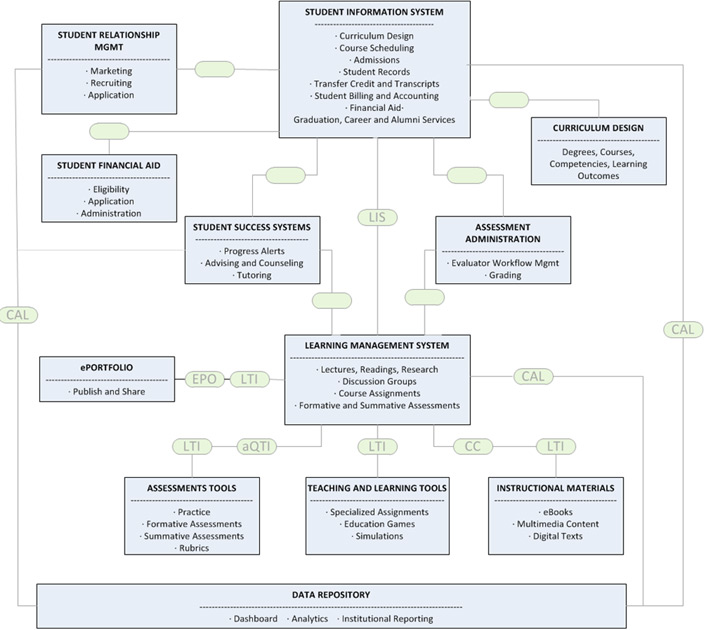Competency Based Education can affect all parts of your institution. What you need to know
Implementing your first Competency-based Education (CBE) program could be daunting. This article, the second in this series, describes how this effort touches every part of an institution, why, and key considerations.
If you haven't read our first article in the series, which introduces CBE and provides links to useful resources, we suggest you start here.
What about CBE creates this impact?
As covered in that article, Competency-based Education represents a completely different way of instructing and measuring students. It removes many of the restrictions placed on students to make education more accessible and inclusive. However, those restrictions have been baked into the way the schools run and manage their institutions. These changes are as follows:
- Courses have flexible start and end times
- Students are instructed differently
- Students are measured differently
- Targeted student demographics are different
How does this affect the institution as a whole?
The fundamental changes previously described have a domino effect on each of the parts of the institution that touch the student. This means that the following will be done differently in a CBE program.
- Recruiting and admissions processes need to target a new type of students
- The curriculum must be designed to be more flexible and to meet the needs of these students
- Course scheduling and enrollment must take into account the flexibility of CBE
- Billing and Financial aid must also take into account the scheduling flexibility
- New ways of assessing and grading students must be developed
- Instructional methods and associated learning tools must be adapted to the flexible schedule and new ways of assessing students
- Institutional research must adopt new ways of measuring and reporting progress and success for these programs at an institutional level
What is the impact to systems and processes?
Each of these changes affect the systems that institutions use to interact with students, manage the learning process, and manage the institution.
© 2014 Pathway Technology Partners
Unfortunately, the systems on the market today (and most likely deployed at your institution) have the restrictions that CBE is eliminating baked into them. Terms, courses, tests, and grades are rigid in these systems and make the more flexible model of CBE very difficult to deploy.
An excellent Educause article goes into more detail with respect to these challenges at institutions looking to adopt CBE. It can be read here.
Getting Started
Now that we understand the complexity and number of stakeholders / moving parts, how do you get started? We recommend a two-stage approach.
- Pick a single degree program to start with.
- Use design thinking to bring all stakeholders together and focus on the most important challenges
Focus on a Single Degree Program
Because this initiative represents a dramatic shift in how an institution operates, the best approach is to identify a degree program to begin with. This will allow you to focus on one type of student, and one area of your curriculum. Not only will it dramatically reduce your work, but it will allow you to be more agile as you learn what works and doesn't work for your institution and culture.
A good example of an institution that took this approach is the University of Louisville, where they began with their Healthcare Leadership track. The program overview shows the unique structure of the offering in the courses tab, with Assessment and Exit courses listed.
We recommend that you choose a program with the following attributes:
- A significant number of potential students would have schedule challenges with a traditional program.
- The faculty in that area are bought into CBE and are willing to lead the charge when it comes to creating curriculum, defining new ways of measuring competency, and changing how they instruct.
- Instruction and assessment can be easily handled for students completing the course at different paces. Support for those students can also be handled at individualized paces.
Use Design Thinking
Once you've identified the program, the next step is to determine how to implement your CBE program. As mentioned above, this involved many different stakeholders, impacting many processes and systems. Each part of the organization must be in alignment in order for this to work.
A technique that accomplishes this called Design Thinking. This is a methodology with the goal of ensuring the premises for which an organization operates (and the systems it utilizes) are a good fit spanning all stakeholders along the way.
Our methodology follows common practices and includes the following steps (applied to the student's perspective for the CBE degree program chosen). The key to success are the following:
- Include all areas of the institution affected by implementing the CBE program. This should be extremely broad from a back office perspective, which is why focusing on a specific program will provide focus on the instruction side.
- Identify and rank all of the potential challenges based on (1) the student-centric view as a consumer of the CBE program, and (2) the current state of curriculum and processes at the institution.
- Ideate and rank all of the potential solutions to the problems identified. All solutions should be organized based on how quickly it would be to implement and the value the solution would provide to the student / organization. This will allow you to draw the line on what to focus on (based on time and resources available).
- Determine next steps which should include testing out different options and determining how to measure success.
This ensures a holistic approach to the solution that breaks down silos, improves collaboration and buy-in, and controls scope.



